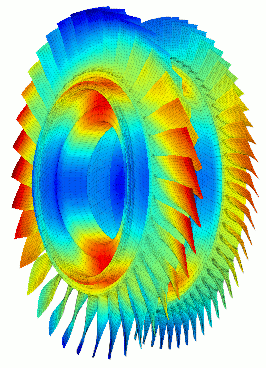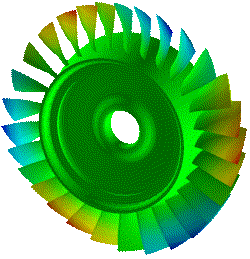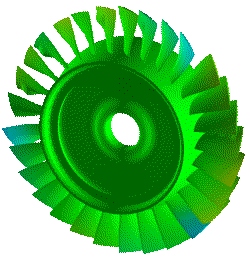

Hello, I am Chandra Shekhar Prasad. At present I am working as postdoc research fellow at Czech Academy of Science in Institute of Thermodynamics, Prague , Czech republic, after obtaining my PhD in Aerospace and Mechanical engineering from University of Liege, Belgium in 2017. My main research areas are Aerodynamics, Aeroelasticity , Computational fluid dynamics (CFD) and Fluid Structure Interaction (FSI). My researchs are focused some of the engineer application related to Wind turbine design & analysis, Gas turbine and Aircraft design & Optimization. I am also very interested in high performence computing and scientific software development. Apart from this I am also interested in renewable energy and new generation of gas turbines with low CO2 emission and High performance steam turbine design for power generation.
Aeroelasticity of gas turbine blades:
The main aim of the research work to simulate the flutter in the gas turbine moving blade. New reduced order CFD method method will be developed for the simulation and coupled with structural solver for the fast and efficient aeroelastic simulation. The effect of traveling waves will be studied, these wave have significant effect on flutter characteristics of blades.
MY LATEST RESEARCH



Fig: Cascade flutter
Fig: Two-nodal diameter vibration mode of a tuned multi-stage assembly
Fig: Vibration pattern of a perfectly tuned assembly under a 3-nodal diameter traveling external forcing
Fig:Vibration pattern of the same assembly, now featuring large mistuning, under the same external forcing
RESEARCH INTERESTS
Aerodynamics:
Aerodynamics is the field of science which study the effect of air on the body moving though it or air flow over it. The concept of aerodynamics is widely used in aircraft design, wind turbine , road vehicle design etc.
I am interested in the computational aerodynamics where I focused on development of new techniques to calculate the aerodynamics forces of the body more efficiently and economically. My research involved in subsonic, supersonic and hypersonic aerodynamics flows. The some of the methods like, 3D Panel method (PM), 3D Vortex lattice method (VLM) and Viscous (Boundary layer)-Inviscid (PM) methods are my focus of interest for low speed aerodynamics flows. These methods I have used in Wind Turbine (WT) aerodynamics, Aircraft design, Rotorcraft design and WT Aeroelasticty.
Computational Fluid Dynamics ( CFD)
CFD is the branch of computational science which normally deal with numerical calculation of fluid flow in general. This is good example of grid based calculation method. Both finite volume (FV) and Finite element (FE) can be used for domain discretization and Navier Stockes (NS) are solved to represent the flow field.
I am mostly interested in the turbulence flow research using Reynold average NS (RANS), Large Eddy Simulation (LES) and Detached Eddy simulation ( DES). Also boundary layer and transitional flows using CFD. I am actively involved research in internal and external flow, and multiphage flows problems using CFD.
Fluid Structure interaction (FSI)
FSI is the branch of computational science which combine study about effect of fluid on solid and vise-versa. There is two kind of FSI coupling strategy are in practice , strong coupling and weak coupling. Both strategy have their advantages and advantages.
Current I am active on both kind of strategies for aeroelastic simulation of gas turbine blades and wind turbine aeroeasticity. I am active in development new tools and method for efficient and fast FSI simulation.
Wind turbine Aerodynamic and Aeroelasticity:
WT are the most commonly used machine to convert wind's kinetic energy into electrical energy. It is the good example of renewable energy generation.
Since last 5 years I am actively involved in numerical modeling and optimization of new generation of wind turbine.I also collaborated with Siemens , Belgium, for the research on wind turbine design and analysis tool development. I am more interested in reduce order aeroelastic mathematical modeling and numerical simulation of WT.
Aerothermodyanmics and hypersonics aerodynamics:
Aerothermodynamics dealing with conditions where there are significant amount of heat exchanges in gases surrounding to the body or significant thermal effects between gas and solid surfaces, this effect are very crucial to determine the lift and drag characteristics of the body moreover to design the heat resistance materials. The aerothermodyanmics is dominating phenomena during high supersonic or hyper sonic flight regime (> mach 4). I am interested in development to numerical tools to accurately simulate the flows. I have been working with Approximate. Riemann Solvers scheme to siumulate the flows for very high mach number (> 15 Mach).
Aircraft design and Multidisciplinary design optimization:
Aircraft design is the engineering process the way aircraft are designed. I am interested in the conceptual aircraft design process. This is the preliminary design phase where the first design of the a aircraft is being conceptualized using customer input requirements. Multidisciplinary design optimization (MDO) in aircraft design field deals with the optimization of the conceptual design to best fit the requirement with lowest cost, the optimization carried out on both structural and aerodynamics shape. I am interested in the filed of new generation civil aircraft e.g, blended wind concept , hybrid power plant integration etc.
High performance computing and software development:
HPC is the numerical computational on bigger scale compare to normal PC. In CFD and FSI field it is very much in practice now days. I have been working and also interested in the development of highly parallel CFD or FSI tools which can be run on multicore machines. These tools use OpenMP, MPI, CUDA , ParMETIS etc, for parallelization. I am interested in development of new algorithms which easily and efficiently can be implemented for the HPC scientific software.